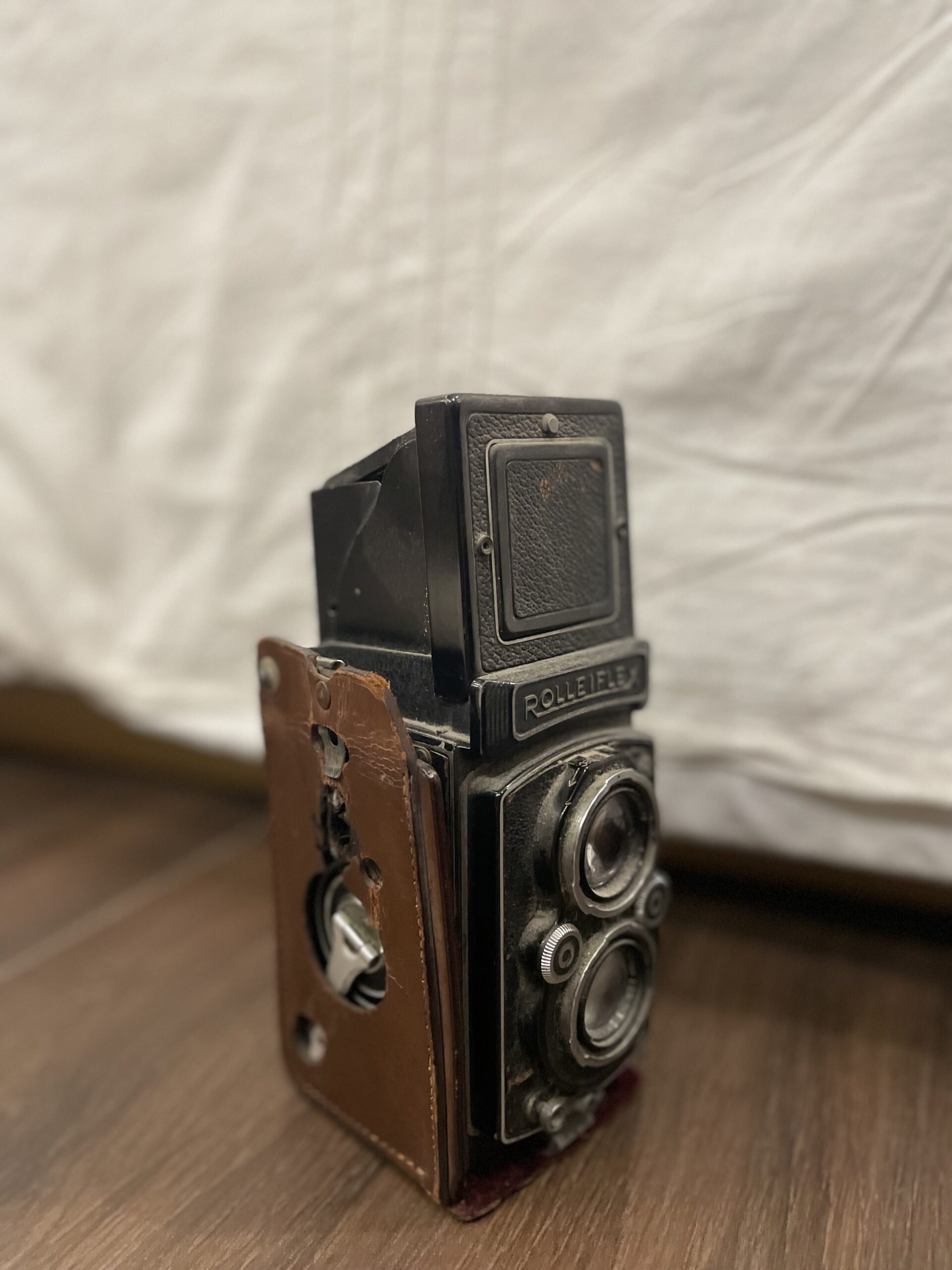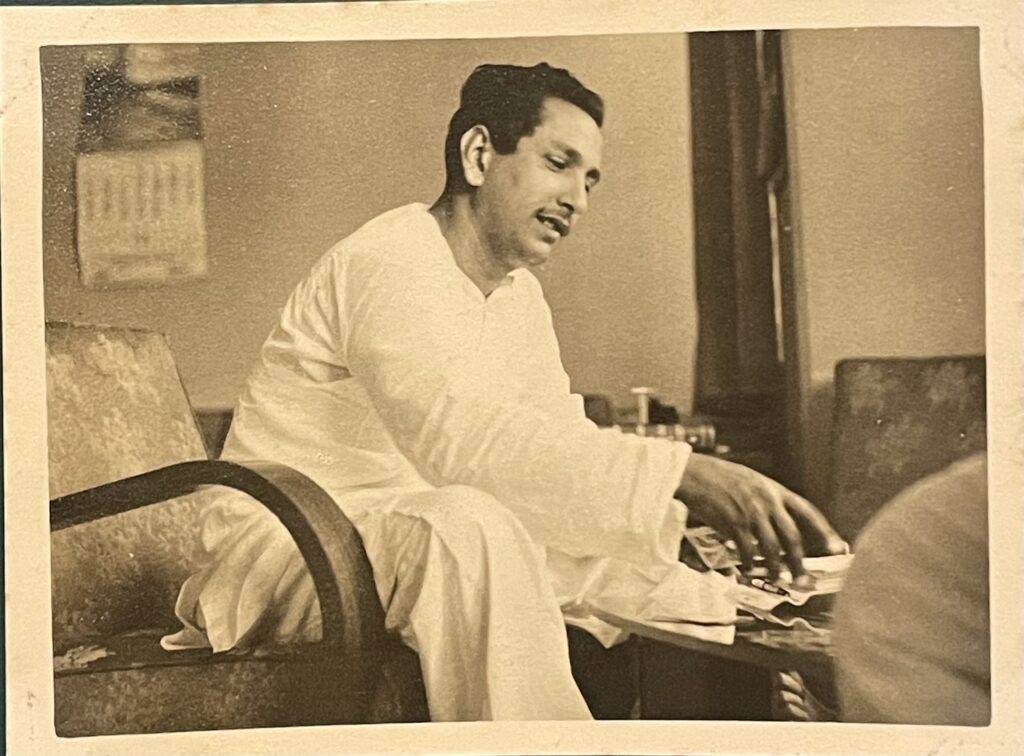TEXT AND PHOTOGRAPHS BY SHANZEH ISHTIAQ
Karachi, Pakistan
A camera sits on my bookshelf- heavy, leather-bound and silent for decades. Once owned by my great-grandfather, S.M Faruque- a man I never knew. Not his voice, nor his demeanor, nor the quiet rituals of his day. And yet, I have come to see fragments of the world as he once did; through the twin lenses of his Rolleiflex camera.
The camera was passed down to my grandmother, my Nano– the youngest of his seven children and the only one who travelled the world with him. She often says she got lucky, simply by being the last, a daughter too precious to be left behind. It was during one of their trips, somewhere in Europe, though she can’t recall exactly, that he bought the Rolleiflex. Today, we don’t have the receipts, the dates, or the stories in full. But we do have the images: square, sepia-toned photographs that hold the outlines of a life.

Sometimes, I think these photographs remember more than we do. In a family where timelines have grown soft and details have slipped, this camera and its images have stayed firm. In Pakistan, many families of that generation have no physical archive to look back on. For many, stories were passed down through the voices of women; mothers, aunts and grandmothers who became the custodians of family history. They carried memories not in albums, but in anecdotes. Not on film, but in the folds of their own recollections. My nano is one of them. With all that she does remember, she has tried to keep the stories behind those photographs alive- not just by remembering, but by retelling.



One of the stories nano did manage to pass on was this: the Rolleiflex was no ordinary camera, and her father was no ordinary man. Born in pre-partitioned India in 1919, S.M. Faruque was a prominent cotton trader- a man of quiet discipline, worldly charm and deep aesthetic instinct. A traditional family man, yes, but also one with a passion for travel, cars, and, as I’ve come to discover through his camera, photography. The Rolleiflex he purchased was both rare and remarkable for its time. Its serial number (752029) suggests early production in Germany, likely the late 1950s to early 1960s. It features a twin-lens reflex with a Zeiss-Opton Tessar 75mm f/3.5 lens, and a 120-film format, shooting 6×6 square images and wrapped in a deep-brown, custom leather case.


In a country where few owned cameras, let alone ones as advanced as this, his choice to bring it home was not driven by status or specifications, but by sentiment. It is a heavy thing, both in weight and in meaning. Especially in a newly born country, where stories of loss were still fresh and having access to photographs wasn’t easy, he had the rare privilege of choosing what to remember. It also makes one wonder of what gets remembered, what doesn’t, and who had the tools (literally) to record their lives at the time. Perhaps that is what makes the Rolleiflex more than a family heirloom- it is evidence of a life that could be documented when so many others could not. My great-grandfather had the means to frame his family’s story, to leave behind tangible proof of his world. But it also makes me think of the countless other lives unfolding alongside his- lives just as vivid, yet unrecorded, surviving only in fragile memories or fading words.


And so, through the Rolleiflex, fragments of his world have survived. Not as grand historical records, but as a small window into his gaze. In the frames he chose, I see the tenderness of a father, the curiosity of a traveler, and the meticulous eye of a man who noticed beauty in the everyday. In one, my great-grandmother sits on the edge of the bed, with a black dupatta drawn over her head, mid-bite, with a lamp casting a delicate shadow across the wall. In another, my nano, eleven years old at the time, stands in a balcony, clutching a small bag of chocolates in her hand as the clock tower rises behind her. There is also one of my great-grandfather himself, hunched over a game of cards, the faint curl of a smile betraying the competitiveness in his eyes. Perhaps my favorite is the one taken in the reflection of a barber’s mirror, the Rolleiflex in his hands, a rare moment where the man behind the camera steps into his own frame. Individually, these images could be dismissed as family keepsakes. But together, they read like a private atlas of the moments he deemed worth preserving.


I have never pressed its shutter or its film, but I’ve spent countless quiet moments
feeling the slight weight of memory in my hands. Despite the efforts to getting it fixed and finding the right film in Pakistan, the camera remains a broken machine, one that acts as a bridge that carries me to a man I never met. An era I never experienced. The photographs remind me that history is not only what survives in books or archives, but also what is saved in private hands. In the end, the Rolleiflex is more than a family heirloom. It is proof that even in silence, some voices still find a way to speak.
